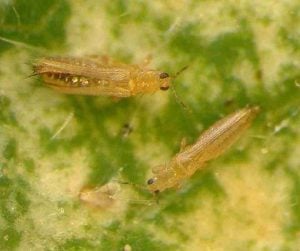-

Thrip damage to flower buds (Pests of Pome and Stone Fruit and their Predators and Parasitoids, Agriculture Victoria)
- Apple and pear flowers are susceptible to attack by thrips from pink bud stage through to petal fall. Two main species are responsible for the damage, but several other minor species may be present.
- The Australian plague thrip Thrips imaginis is often the main cause of damage over flowering and can appear suddenly in the orchard, having blown in from long distances in plague proportions.
- Western flower thrips (WFT) Frankliniella occidentalis overwinters on broad-leaved weeds in or near the orchard and moves into the trees when the herbage starts to dry out (naturally or because of herbicide applications) or mowing has removed weed flowers.
- Onion thrips Thrips tabaci, tomato thrips Frankliniella schultzei, are other species that may be present and could be confused with WFT or plague thrips. The two species of Thrips have 7-segmented antennae and the two species of Frankliniella have 8-segmented antennae but these characteristics and other diagnostic features are difficult to see without the aid of a microscope.
- Thrips feeding on developing flowers can cause the flowers to desiccate and abort if large numbers of thrips are present. Immature and mature thrips feed on the developing flowers.
- Historically, a threshold of 6-8 thrips/flower has been used to determine the need for spraying but this has not been revised as new pesticides became available.WFT is resistant to many pesticides and resistant strains develop so quickly that written publications become out of date before they are printed.
- WFT tends to remain in the orchard throughout the season and can attack apple fruit in the lead up to harvest, causing pansy spots that cause the fruit to be downgraded.
- Yellow or blue sticky traps can be used throughout the season to monitor activity of plague thrips and WFT. They have the added benefits of detecting dimple bug and allowing monitoring
activity of beneficial species. - Pesticides used to control WFT and plague thrips over flowering have the potential to disrupt IPDM for most other pests so check their known impact on beneficials and choose carefully

Adult western flower thrips (Pests of Pome and Stone Fruit and their Parasitoids, Agriculture Victoria)
Further Information:
For more detailed information on thrips see pages 288 – 294 IPDM Manual: https://extensionaus.com.au/ozapplepearipdm/wp-content/uploads/sites/15/2021/04/2020-final-accepted-version-Apple-and-Pear-IPDM_V3.pdf
A useful guide on Thrip identification by NSW DPI in Pome and Stone fruit: https://www.dpi.nsw.gov.au/__data/assets/pdf_file/0011/177329/stone-and-pome-thrips.pdf

One comment, add yours.
Kylie
One of these bugs was in big w Victoria Australia